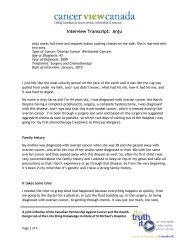A Guide to Implementing Best Practices in Person ... - cancerview.ca
A Guide to Implementing Best Practices in Person ... - cancerview.ca
A Guide to Implementing Best Practices in Person ... - cancerview.ca
Create successful ePaper yourself
Turn your PDF publications into a flip-book with our unique Google optimized e-Paper software.
Navigation: A <strong>Guide</strong> <strong>to</strong> <strong>Implement<strong>in</strong>g</strong> <strong>Person</strong>-Centred Care September 2012Provid<strong>in</strong>g Emotional and Supportive CareThis doma<strong>in</strong> comprises competency standards that reflect the ability of naviga<strong>to</strong>rs <strong>to</strong>identify multiple physi<strong>ca</strong>l, psychologi<strong>ca</strong>l, social, sexual and spiritual needs of clientsthroughout the cont<strong>in</strong>uum of <strong>ca</strong>ncer <strong>ca</strong>re. It is also about naviga<strong>to</strong>rs’ abilities <strong>to</strong> implementevidence-based supportive <strong>ca</strong>re <strong>in</strong>terventions <strong>in</strong> a flexible and responsivemanner <strong>in</strong> the context of a collaborative <strong>in</strong>terdiscipl<strong>in</strong>ary approach <strong>to</strong> <strong>ca</strong>re. The ability<strong>to</strong> identify sources of distress and <strong>to</strong> help patients manage and cope with such distressis a criti<strong>ca</strong>l dimension of the naviga<strong>to</strong>r role. To provide emotional and supportive <strong>ca</strong>rerequires exploration of fears and anxieties about disease progression, mortality, dy<strong>in</strong>g,body image or sexual health. Screen<strong>in</strong>g for Distress is a method of rapidly identify<strong>in</strong>gpatients with psychosocial distress. For more <strong>in</strong>formation about the implementation ofScreen<strong>in</strong>g for Distress, refer <strong>to</strong> Integrat<strong>in</strong>g Screen<strong>in</strong>g for Distress, The 6th Vital Sign <strong>in</strong>Chapter 5.Competencies <strong>in</strong> this area demonstrate the personal, collaborative and therapeuti<strong>ca</strong>pproach, which enhances the effectiveness naviga<strong>to</strong>rs. These competencies speak <strong>to</strong>the criti<strong>ca</strong>l importance of <strong>in</strong>terpersonal transactions.In this doma<strong>in</strong>, professional naviga<strong>to</strong>rs:• establish therapeutic relationships with patients, families and other <strong>ca</strong>regivers <strong>to</strong>facilitate cop<strong>in</strong>g with sensitive issues;• facilitate patient and family decision-mak<strong>in</strong>g regard<strong>in</strong>g complex treatment, symp<strong>to</strong>mmanagement and end-of-life <strong>ca</strong>re;• assess sources of psychosocial and spiritual distress and plan appropriate management;• engage <strong>in</strong> therapeutic conversations, explor<strong>in</strong>g fears and anxieties about disease,treatment, side-effects and outcomes;• refer patients and families <strong>to</strong> appropriate support services;• perform comprehensive and timely assessment <strong>to</strong> identify current and potentialneeds and concerns;• foster cop<strong>in</strong>g skills us<strong>in</strong>g exist<strong>in</strong>g supports and resources <strong>to</strong> ma<strong>in</strong>ta<strong>in</strong> or improveeach patient’s quality of life;• facilitate and support each patient’s ability <strong>to</strong> make decisions, solve problems, andset and prioritize goals;• collaborate with the <strong>in</strong>terdiscipl<strong>in</strong>ary team <strong>to</strong> optimize health outcomes and accessservices and resources.16













